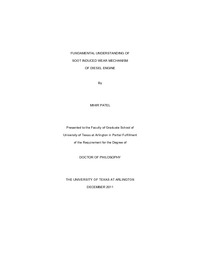
ATTENTION: The works hosted here are being migrated to a new repository that will consolidate resources, improve discoverability, and better show UTA's research impact on the global community. We will update authors as the migration progresses. Please see MavMatrix for more information.
Show simple item record
| dc.contributor.author | Patel, Mihir | en_US |
| dc.date.accessioned | 2014-09-17T17:29:54Z | |
| dc.date.available | 2014-09-17T17:29:54Z | |
| dc.date.issued | 2014-09-17 | |
| dc.date.submitted | January 2011 | en_US |
| dc.identifier.other | DISS-11372 | en_US |
| dc.identifier.uri | http://hdl.handle.net/10106/24742 | |
| dc.description.abstract | Emission of Oxides of nitrogen and particulates matters from diesel engines have been reduced by implementing exhaust gas recirculation (EGR) protocols but at the expense of increased wear of engine components. This problem is aggravated by Environment Protection Agency (EPA) regulation such as API CJ 4 and SAPS where chemical limits have been places on the amount of phosphorous, sulfur and sulfated ash in lubrication oil. Several studies have examined the role played by diesel soot on enhanced wear but none have provided comprehensive mechanism. This would allow the possibility to comprehend fundamental understanding of soot induced wear mechanism of diesel engine. This work begins with a study of the structure, composition and morphology of diesel soot extracted from the drain interval crankcase oil of the commercially operated diesel engine to comprehend the interaction between lubrication additives chemistries and diesel soot. The interaction was comprehended by characterizing diesel soot using Transmission Electron Microscopy (TEM), Synchrotron X-ray Diffraction, Raman Spectroscopy (SR-XRD), X-ray Absorption Near Edge Spectroscopy (XANES) and High-resolution Transmission Electron Microscopy (HRTEM). The tribological assessment of the lubricant formulation blended with diesel soot was conducted using four ball wear tester and SRV friction tester. Laboratory simulation was carried out understand the interaction between lubricants additives chemistries and carbon black (soot surrogate). Carbon black was blended with lubricants and treated in various conditions to forced the interaction and thereby comprehend the conditions that are responsible to induced the interaction between carbon black (soot surrogate) and lubricants additives chemistries. XANES, TEM and Raman spectroscopy were used to study the structure, composition and morphology of extracted carbon black and compared with diesel soot. Four ball wear tested and SRV friction test were employed for tribological evaluation. SEM was used to understand the morphology of wear track. Diesel soots were also extracted from the dynamometer diesel engine tests such as Mack T 8A, Mack T 11, Mack T 12, Cummins ISM, Cummins ISM, GM RFWT. Diesel soots extracted from the drain interval crankcase oil of the dynamometer tests have experienced controlled engine operation. Studies were conducted to correlate the effect of operational parameters such as load, speed, temperature and oil chemistries of the dynamometer engine test and structure and composition of diesel soot. Engine components such as piston ring, header, roller follower pin were also investigated to understand the effect of diesel soot on tribofilm formation and its structure. XANES, HRTEM, SR-XRD, Raman spectroscopy, SEM were used to examine the soot and tribofilm. | en_US |
| dc.description.sponsorship | Aswath, Pranesh | en_US |
| dc.language.iso | en | en_US |
| dc.publisher | Materials Science & Engineering | en_US |
| dc.title | Fundamental Understanding Of Soot Induced Wear Mechanism Of Diesel Engines | en_US |
| dc.type | Ph.D. | en_US |
| dc.contributor.committeeChair | Aswath, Pranesh B. | en_US |
| dc.degree.department | Materials Science & Engineering | en_US |
| dc.degree.discipline | Materials Science & Engineering | en_US |
| dc.degree.grantor | University of Texas at Arlington | en_US |
| dc.degree.level | doctoral | en_US |
| dc.degree.name | Ph.D. | en_US |
Files in this item
- Name:
- Patel_uta_2502D_11372.pdf
- Size:
- 23.22Mb
- Format:
- PDF
This item appears in the following Collection(s)
Show simple item record


